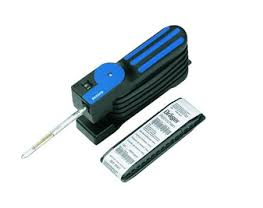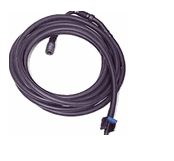
Drager Toxic Gas Detector Extension Hoses Correction Factor
Chemical detector tubes:
These instruments, often referred to as Draeger tubes, normally function by drawing a sample of the atmosphere to be tested through a proprietary chemical reagent in a glass tube.
The detecting reagent becomes progressively discoloured if a contaminant vapour is present in the sample. The length of the discoloration stain gives a measure of the concentration of the chemical vapour which can be read from the graduated scale printed on the tube. Detector tubes give an accurate indication of chemical vapour concentration, whatever the oxygen content of the mixture
The detecting reagent becomes progressively discoloured if a contaminant vapour is present in the sample. The length of the discoloration stain gives a measure of the concentration of the chemical vapour which can be read from the graduated scale printed on the tube. Detector tubes give an accurate indication of chemical vapour concentration, whatever the oxygen content of the mixture
It is important that the correct volume of atmosphere sample, according to the manufacturer's instructions, is passed through the tube, otherwise the measurement will not be accurate. Too small a sample volume will give a low value. With some instruments the length of hose is a critical factor in obtaining a correct reading. The presence of a second gas may affect readings and cause inaccuracies. Chemical detector tubes are specific for particular gases or vapours, which need not have flammable or combustible properties - for example, oxygen or water vapour (to establish dewpoint).

Fig: Draegar tube
The tubes are designed to measure low vapour concentrations accurately, and are probably the most convenient and suitable equipment to use. They should always be used when the cargo vapour presents a serious inhalation hazard, e.g. acrylonitrile. The storage life of these tubes is usually limited, and it is necessary to ensure that out of date tubes do not remain available for use.

Fig: Extension hose
In the recent past it has been observed that there has been an increase in the number of instances in the chemical fleet where the crew is not familiar with the extension hose correction factors when using Dräger toxic gas detectors. Below guideline highlighting importance of applying the correction factors.
An extension hose provides a convenient means to test the air quality in difficult to reach areas prior to entry. One end of the hose is equipped with an adapter to connect the extension tube securely to the gas detector pump. The other end of the hose has a tube holder assembly which provides a gas tight fit when the Dräger Tube is inserted.
Since the Dräger Tube is connected at the inlet of the extension hose and the gas detector pump is connected at the outlet end of the extension hose, the volume of the hose has little influence on the reading. However, when Dräger tubes are used in conjunction with 10 or 15 metre length extension hoses, a correction factor requires to be applied for certain tubes. The reading obtained on the tube requires to be multiplied by this correction factor. As can be seen, the gases this applies to are those which are commonly encountered on board ships.
Single-stroke measurement
Draw the sampling air through the tube with 1 pump stroke. When the stroke is finished -the white indicator mark on the pump becomes visible - allow for a waiting period of 2 minutes before removing the tube from the sampling point. Evaluation is effected in accordance with the instructions for use of the tube in question. Correction of the measuring result is not required for the single-stroke measurement.
Several-stroke measurement
Draw the sampling air through the tube with the specified number of strokes. Always perform the next stroke once the white indicator mark becomes visible. No waiting period is required after the final stroke. If several-stroke measurement is performed by means of 10 m or 15 m extension hoses, the tube reading of some of the Dräger Tubes must be multiplied by a correction factor.
Why is a correction required?
With a 3 m extension hose, the error is immaterial and is not worthy of consideration. In fact, if your measurements are based on single stroke measurement, no correction is required to be applied with 10m or 15m tube lengths. It is only required to be used, when you have multiple stroke measurements with a tube.
The reason can be found in the way the chemical reactions take place in the tube. A number of chemical reactions are used in such tubes and these include:
1. rapid reactions which are independent of the flow rate through the tube;
2. rapid reactions with secondary reactions which may depend on the flow rate through the tube;
3. consecutive reactions in which the vapor reacts with one reagent to produce products that are detected by reaction with a second reagent;
4. Reactions where a large excess of reagent is necessary.
For tubes involving reactions (3) and (4), flow rate is often critical because the reaction rate with the reagent can be slow. In addition some tubes involve the use of a pre-cleansing layer of a reagent which is intended to remove possible interfering substances.
What correction to apply?
The volume which is conveyed with each pump stroke is not changed when the extension hose is used, however, the flow characteristic which is typical of the Dräger gas detector pump may be subject to changes. This in turn results in a change of the opening time of the gas detector pump.
For some Dräger Tubes in conjunction with 10 or 15 meter extension hoses, such change is liable to cause errors in the readings. The reading must therefore be corrected. Given a hose length of 3 m, however, the change in the opening time is so insignificant that the influence on the measuring result can be neglected in any case. The
Other info pages
Draegar Chemical detector tubes use and reading correction guideline
These instruments, often referred to as Draeger tubes, normally function by drawing a sample of the atmosphere to be tested through a proprietary chemical reagent in a glass tube. The detecting reagent becomes progressively discoloured if a contaminant vapour is present in the sample. The length of the discoloration stain gives a measure of the concentration of the chemical vapour which can be read from the graduated scale printed on the tube. Detector tubes give an accurate indication of chemical vapour concentration, whatever the oxygen content of the mixture
Requirements of various grade chemical cargo heating
: The voyage orders will contain heating information, if heating is required. As a rule the final heating instructions are given by the Shipper in writing to the Master / Chief Officer in the port of loading. If those written instructions are not given, the master should request them and issue a Letter of Protest if they are not received at departure. In the latter case the management office should be immediately informed.
Recommended temperature monitoring equipments onboard
:Temperature sensors are fitted so that the temperature of the cargo can be monitored, especially where required by the IBC Code. It is important to know the cargo temperature in order to be able to calculate the weight of cargo on board, and because tanks or their coatings often have a maximum temperature limit. Many cargoes are temperature sensitive, and can be damaged by overheating or if permitted to solidify. Sensors may also be fitted to monitor the temperatures of the structure around the cargo system.
Cargo instruments
:In order to maintain a proper control of the tank atmosphere and to check the effectiveness of gas freeing, especially prior to tank entry, several different gas measuring instruments need to be available for use. Which one to use will depend upon the type of atmosphere being measured.
Liquid level gauges
:The accuracy required of chemical carrier level gauges is high because of the nature and value of the cargo. To limit personnel exposure to chemicals or their vapours while cargo is being handled, or during carriage at sea, the IBC Code specifies three methods of gauging the level of a liquid in a tank - open, restricted or closed
Overflow control
:Certain cargoes require the designated tank to be fitted with a separate high level alarm to give warning before the tank becomes full. The alarm may be activated by either a float operating a switch device, a capacitive pressure transmitter, or an ultrasonic or radioactive source. The activation point is usually pre-set at 95% of tank capacity.
Oxygen analysers
:Oxygen analysers are normally used to determine the oxygen level in the atmosphere of an enclosed space: for instance, to check that a cargo tank can be considered fully inerted, or whether a compartment is safe for entry.
Vapour detection
:Ships carrying toxic or flammable products (or both) should be equipped with at least two instruments that are designed and calibrated for testing the gases of the products carried. If the instruments are not capable of testing for both toxic concentrations and flammable concentrations, then separate sets of instruments should be provided.
Alarm circuit
:An important feature of many modern measurement and control instruments is the ability to signal a particular situation. This can be a main operational alarm that gives an indication of a pre-set situation such as liquid level in a tank, or a malfunction alarm indicating a failure within a sensor's own operating mechanism. The designs and purposes of alarm and shutdown circuits vary widely, and their operating system may be pneumatic, hydraulic, electrical or electronic. Safe operation of plant and systems depends on the correct operation of these circuits and a knowledgeable reaction to them.
Gas freeing
:Gas freeing onboard chemical tankers is required for entry into cargo tanks, for hot works or washing for clean ballast tanks. Gas Freeing is one of the most hazardous operations routinely undertaken onboard a Chemical Tanker and the additional risk created by cargo gases expelled from the tanks, which may be toxic, flammable and corrosive, cannot be over-emphasised.
Cargo tank damage during pigging operations
:Blowing and pigging of pipelines at terminals poses inherent risks for the terminal and a chemical tanker. Frequent damages to tanks have occurred. If there are doubts about the shore operation or signs of problems ashore the OOW must immediately request clarification.
Reference publications
- Equipment Manufacturers Instruction Manuals
- MARPOL ?73/78 (latest consolidated edition)
- International Safety Guide for Oil Tankers and Terminals (ISGOTT)
- CFR 33 parts 125 to 199
- Ship to Ship Transfer Guide (Petroleum)
- MSDS for particular cargo carried
- Chemical Tank Cleaning Guide
Main Info pages!
Home page ||| Chemical hazards ||| Cargo planning & Stowage ||| Cargo loading ||| Cargo documents ||| Safe stability ||| Cargo care ||| Preparation for unloading ||| Inert gas systems |||Gas freeing ||| Nitrogen handling ||| Chemical handling Safe practice |||Handling equipments ||| Cargo & Ballast pumps ||| Cargo tanks |||Tank cleaning |||Special cargoes |||Spills emergencies |||Fire protection
Chemicaltankerguide.com is merely an informational site about various aspects of chemical tankers and safety tips that may be particular value to those working in: Chemical Handling, Chemical Storage, Liquefied Chemical Suppliers, Chemical Shipping, Chemical Transportation, Chemical Terminals, Bulk Chemical Services and Chemical Processing. If you are interested in finding out more about chemical tanker guideline please visit IMO official website. For any comment please Contact us
Copyright © 2011 Chemical Tanker Guide.com All rights reserved.
